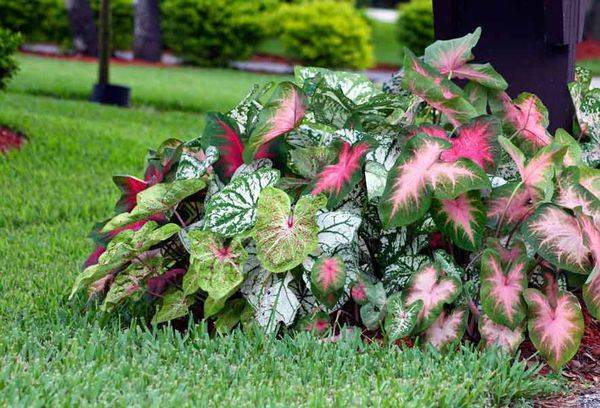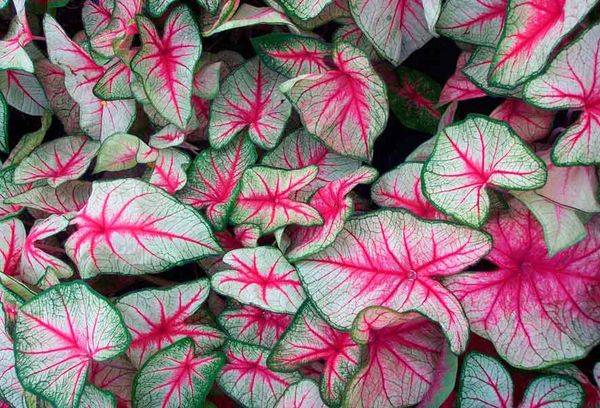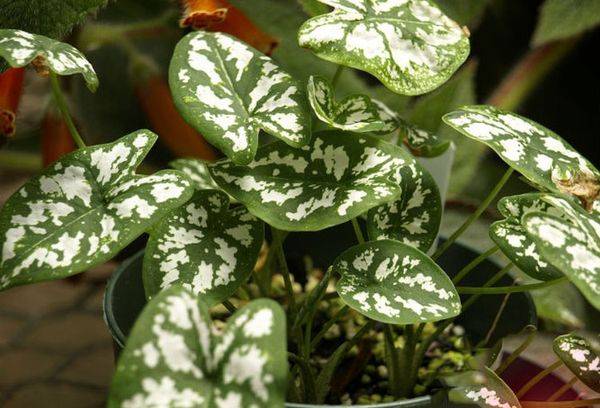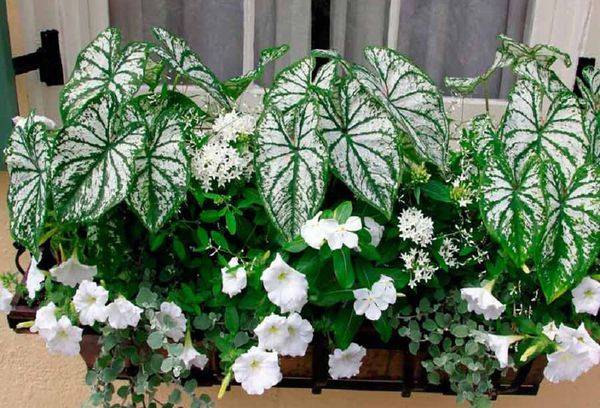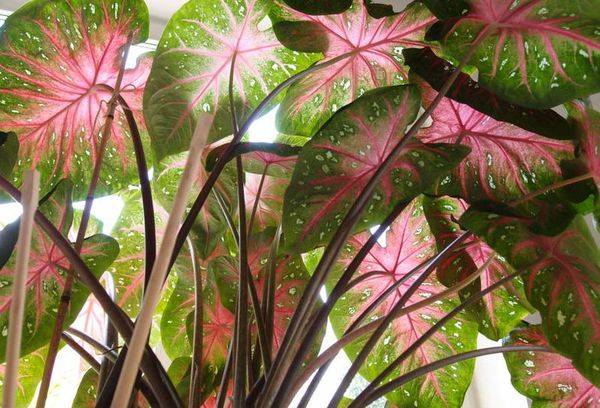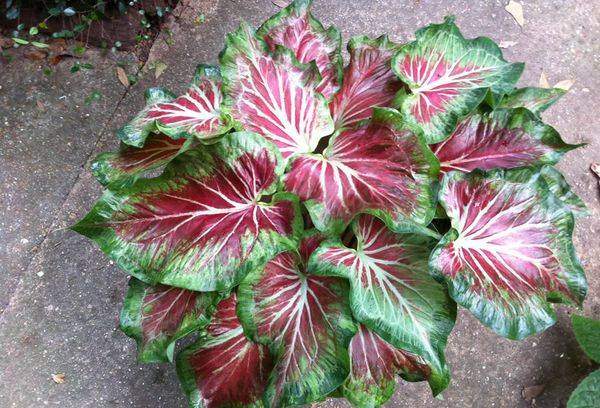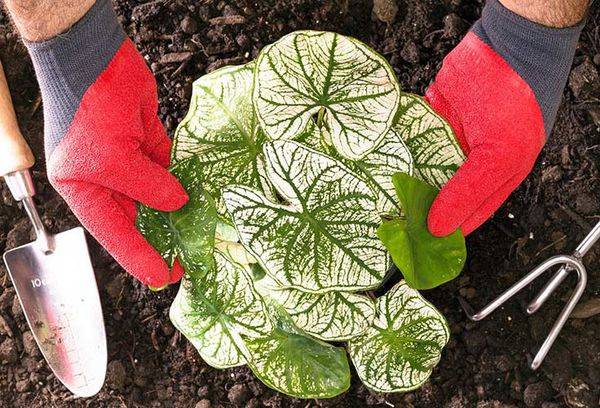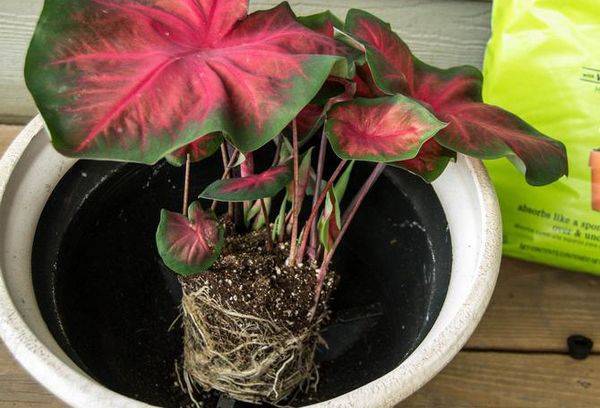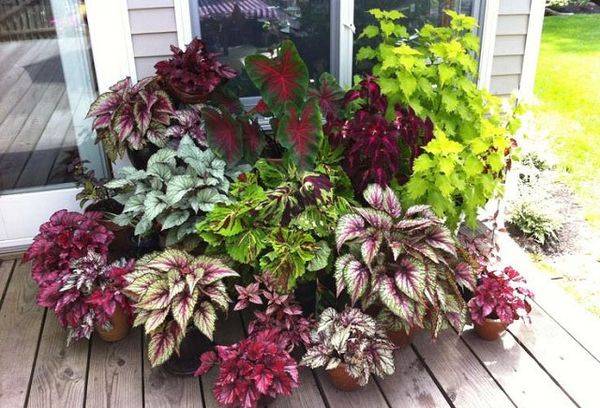Angel Wings: How to Grow Caladium at Home
Content:
“Angel wings”, “Heart of Jesus”, “Christ's heart” - all these poetic names are assigned to a decorative flower - caladium. Caring for it at home is quite simple, so the plant is valued by flower growers. The main reason for the popularity is the graceful leaves of a heart-shaped shape and various shades. About the rules for caring for the flower and the possible difficulties of growing it is worth learning more.
Description
Kaladium (Kaladium) - a small genus of the Aroid family, including 16 species. His homeland is South America (Amazon rainforest). These herbaceous perennials have one feature, for which they are loved by flower growers all over the world: the shape of a leaf of caladium resembles a heart. The sheet has clear and contrasting veins, the sheet plate is leathery, thin. A variety of its shades also speaks in favor of a decorative plant.
The root system of the plant is fibrous. Caladium tubers are dark brown, with a diameter of 7-10 cm. In the center of the tuber is the base of the bush, and sleeping buds are located on the sides. The plant does not have a stem: leaves grow from a bud on long stalks. From rosettes of leaves, bushes up to 90 cm in diameter are formed. In the wild, the length of the leaf plate can reach 45 cm, at home it averages 20-30 cm. Caladium grows up to 1.5 m in height.
The plant blooms in modest white or green inflorescences from male and female flowers. The flowering period takes several days. Then, after 2 months, the fruits of caladium ripen - round reddish-orange berries. The life span of a home flower is 2-3 years.
Varieties
For decorative purposes, mainly hybrids are grown. But species caladiums are interesting in their own way.
- Caladium Humboldt (myostimma, argintes) - Brazilian flower. A distinctive feature is the dark green surface of the arrow-shaped leaves with silver dots.
- Caladium of Schomburg - a flower from Brazil with beautiful oval leaves, between the veins - silver areas.
- Caladium Bicolor - the owner of leaves up to 30 cm long, the color of which varies from green to red with spots of various shapes. Homeland - Antilles and mountainous areas of Brazil.
All hybrids are obtained by crossing these three species. Most popular among gardeners:
- White Christmas - an unusual combination of white sheet, dark green spots and veins;
- Florida Cardinal - saturated raspberry leaf center and a wide green border;
- Pink Cloud - The owner of an interesting leaf color: in the center they are scarlet, and closer to the edges are soft pink with a green frame;
- Rosalie - red leaves with thin or wide green veins;
- Sea Gull - The owner of beautiful green leaves with white veins.
Care rules: lighting, temperature, humidity
The first condition is lighting. Light should be diffused, but intense. Caladiums feel good on the north-east and north-west windows. In general, the plant is quite shade-tolerant.
For a year, caladium passes through two stages: a growth period and a dormant period. Each stage requires a different room temperature. So, during the growing season, you need to provide the flower with a temperature not lower than +20 ⁰C, and preferably +25 ⁰C. During dormancy, the plant sheds all the leaves, and its tubers are stored at a temperature of + 16-18 ⁰C.
Indoor flower tolerates high humidity. Insufficient humidity often causes problems and can even destroy the plant.
Tip
Spray moisture over the caladium, but beware of direct drops of water on the leaves. They may stain or lose color saturation.
Watering and fertilizer
Watering during the growing season should be regular. Water for irrigation - settled, room temperature. Each subsequent watering is done after the topsoil has dried. purityis.decorexpro.com/en/ recommends not waiting for the substrate to dry completely, as the broad leaves of the caladium will actively evaporate moisture. Since the end of August, watering has been gradually reduced to drop leaves. During dormancy, the soil can occasionally be moistened with a small amount of water.
When a plant goes into dormancy, its tubers are stored in the same soil and in the same pot. In February-March, tubers are removed, cleaned of old roots and planted in new soil. Watering resumes gradually, using soft and warm water. After a few days, roots begin to form, and then leaves. As they grow, watering increases.
Fertilizers are applied after the end of shoot growth. Once a week, the flower is fed with mineral preparations containing nitrogen, phosphorus and potassium in equal amounts. Fertilizer concentration is indicated on the packaging. Lure continues until early August.
The main difficulty in growing a flower is its withdrawal from a state of rest. The rest of the caladium is quite unpretentious, so even a beginner grower can cope with its content at home.
Transplantation, reproduction
The transplant is carried out annually after a period of rest. The ideal size of the container is when at least 4 cm remains from the tuber to the wall. Two small tubers can be placed in one container, only you need to leave a distance between them so that everyone can fully develop.
How to transplant?
- A drain is placed at the bottom of the pot.
- The soil mixture is laid on top: humus, leafy earth, peat, sand (2: 2: 2: 1).
- Then the tuber is placed with its eyes up and covered with the remaining soil to the base of the upper eye.
- If the tuber has no eyes, then do not fill it with soil, but place it in the greenhouse. There, after 2-3 weeks, the eyes wake up.
- Soil temperature is maintained at + 25⁰ C, watering is moderate.
Reproduction occurs in two ways.
- The seeds. Not the best way, as the plant loses its distinguishing features. You can try to artificially pollinate caladium. Its seeds ripen after 2 months. Planting seeds should be immediately after collection in a mixture of sheet soil and sand (4: 1). Provide good drainage to improve seed germination.
- Subsidiary tubers. The main tuber is divided into parts, each of which should have kidneys. The surface of the cuts is recommended to be treated with charcoal. Daughter tubers are planted in a mixture of peat and sand and left in a warm bright place.
Diseases, pests and other problems
Unpleasant episodes can occur in growing Caladium. These heart-shaped householders can be attacked by pests. Most often, aphids, spider mites, mealybugs encroach on a flower. The problem is solved by treating the plant with insecticides.
Rhizomes are sometimes affected by a fungus. Diseases such as fusarium or wet bacterial rot are treated with powdered fungicide preparations. Among the common problems of the plant is late blight. With this disease, the leaves of caladium begin to turn yellow. The harmful effect of the fungus is also stopped with the help of a fungicide.
Some growing problems and their causes:
- lower leaves dried up - not enough moisture;
- leaf edge dried up - excess heat, sunburn, excess fertilizer;
- tuber decay - waterlogging of the substrate during dormancy;
- brown spots - drops of water falling on the leaf provoked the development of the fungus.
It is interesting
With this knowledge you can surprise guests who pay attention to the "angel wings."
- Another popular name for the flower is "elephant ears."
- The name is translated from the Malay language as "plant with an edible root." Several species are really eaten: Caladium tubers are rich in starch.
- In humid tropical forests, caladiums reach a height of 5 m.
- People in the tropics often flee from the rain under the broad leaves of caladium.
- According to the observations of botanists, on the leaves of caladium you can find all shades, except for blue and blue.
There are so many reasons to grow caladium at home: this plant is unpretentious, looks spectacular, easily propagates. In addition, it is nice to grow a flower with an angelic name.
